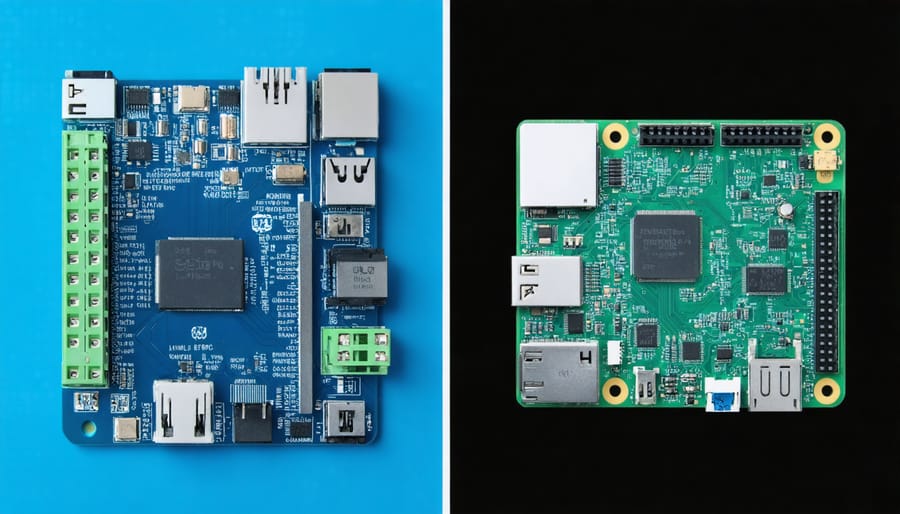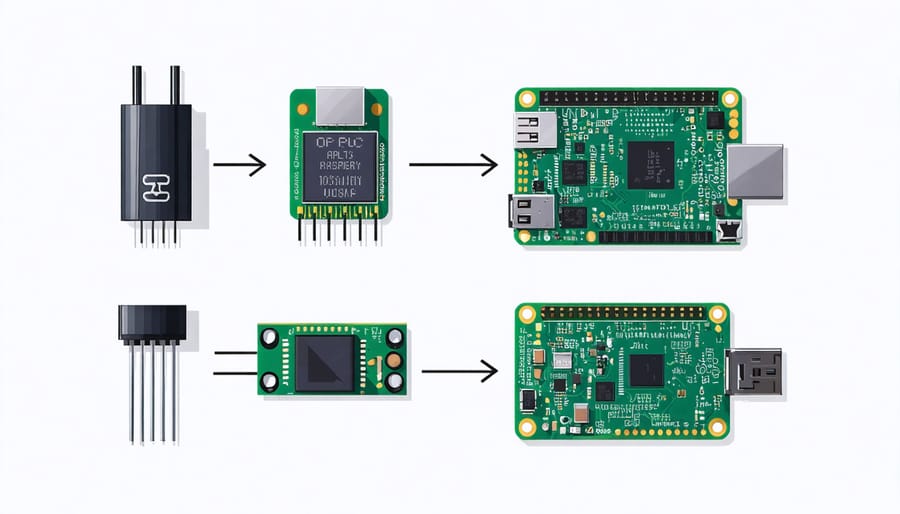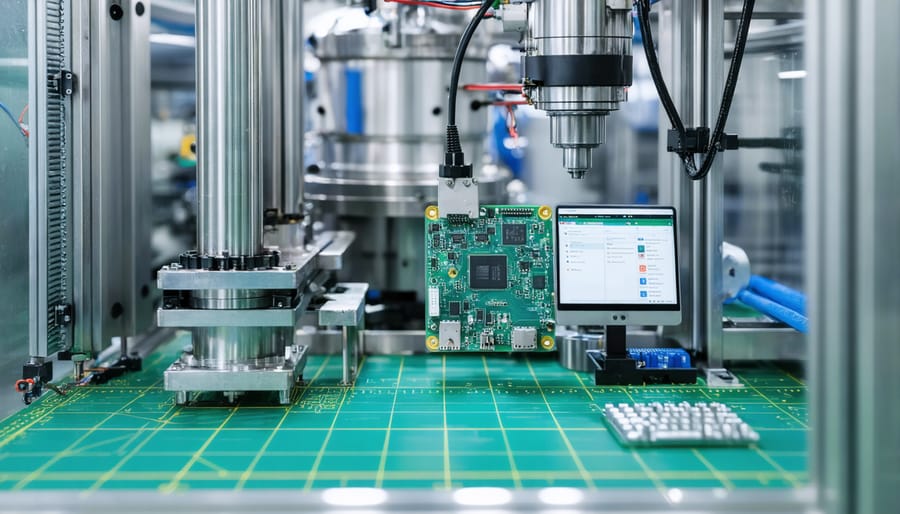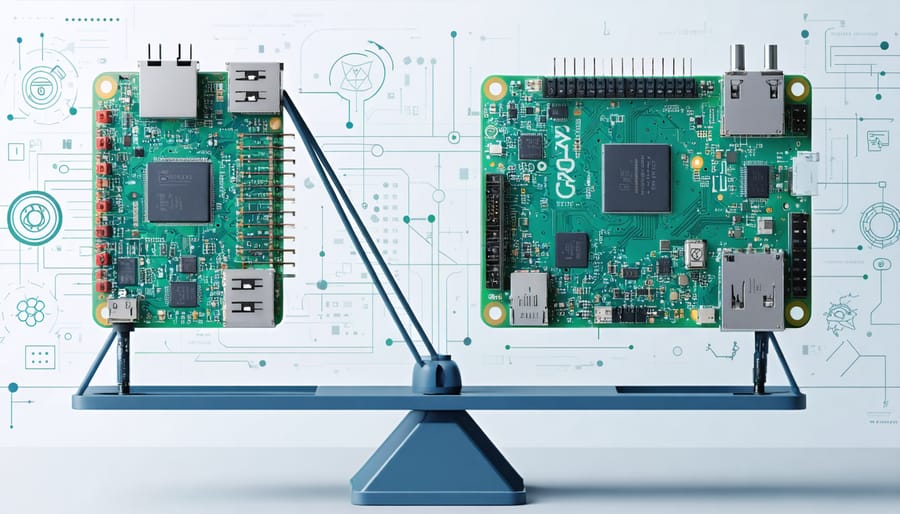Transform your industrial control systems with Raspberry Pi – a powerful, cost-effective alternative that’s revolutionizing modern automation. While not a traditional PLC, Raspberry Pi’s versatility in industrial automation with Raspberry Pi offers unique advantages through its Linux-based architecture, extensive GPIO capabilities, and robust programming flexibility. Think of it as a hybrid solution that bridges the gap between conventional PLCs and modern computing platforms, offering real-time control capabilities at a fraction of the cost.
Unlike traditional PLCs, Raspberry Pi provides advanced features like network connectivity, database integration, and sophisticated HMI development – all while maintaining the ability to handle basic I/O operations essential for industrial control. However, it’s crucial to understand that implementing a Raspberry Pi-based control system requires additional considerations for industrial-grade protection, reliable power supply, and proper I/O isolation to match the robustness of traditional PLCs in harsh industrial environments.
This comprehensive guide explores how Raspberry Pi can serve as a PLC alternative, examining its capabilities, limitations, and practical implementation strategies for both hobbyists and professional automation engineers.
Understanding PLCs and Raspberry Pi

Traditional PLC Characteristics
Traditional PLCs are purpose-built industrial control systems designed to operate in harsh environments with exceptional reliability. They feature robust metal enclosures, industrial-grade components, and specialized input/output modules that can withstand extreme temperatures, electrical noise, and vibrations. These devices typically run real-time operating systems that ensure consistent scan times and deterministic behavior, crucial for precise automation control.
A key characteristic of industrial PLCs is their compliance with safety standards and certifications like IEC 61131-3, which governs PLC programming languages, and UL/CE markings for safety compliance. They offer built-in surge protection, electrical isolation, and redundancy features that protect both the equipment and the facility.
PLCs are designed for 24/7 operation with mean time between failures (MTBF) measured in years. They use specialized programming software and communicate via industrial protocols like Modbus, Profinet, or EtherNet/IP. While these features make traditional PLCs highly reliable and secure, they also contribute to their higher cost compared to alternative solutions.
Raspberry Pi Industrial Capabilities
The Raspberry Pi demonstrates remarkable potential for industrial applications, offering features that make it suitable for certain automation tasks. Its GPIO pins allow direct connection to sensors, actuators, and other industrial devices, while its processing power can handle complex control algorithms and data processing tasks. The device supports various industrial communication protocols like Modbus, MQTT, and OPC-UA through additional software implementations.
With its compact form factor and low power consumption, the Raspberry Pi can be integrated into existing industrial setups without requiring significant infrastructure changes. It excels in data logging, monitoring systems, and basic process control applications. The ability to run a full Linux operating system enables sophisticated programming capabilities and remote management options.
However, it’s important to note that the Raspberry Pi wasn’t specifically designed for industrial environments. While it can be adapted for industrial use through proper enclosures and protection measures, it may require additional hardware considerations to match the robustness and reliability of traditional PLCs. This includes implementing surge protection, proper cooling systems, and redundancy measures for critical applications.
Converting Raspberry Pi into a PLC-like Device
Hardware Requirements
To transform a Raspberry Pi into a functional PLC, you’ll need several essential hardware components to ensure reliable operation and industrial-grade performance. The foundation starts with a Raspberry Pi 4 Model B (recommended for its processing power) with at least 2GB RAM, though 4GB is preferred for more demanding applications.
Protection is crucial in industrial environments, so you’ll need a DIN rail mounting case with proper ventilation to shield your Pi from dust and physical damage. For reliable power supply, use an industrial-grade 24V DC power supply with a step-down converter to provide stable 5V DC to the Pi.
For connecting industrial sensors and actuators, you’ll need interface boards that provide isolation and level shifting. Essential components include:
– Input/output expansion board (HAT)
– Optocouplers for digital inputs
– Relay modules for digital outputs
– Analog-to-digital converters (ADC) for analog inputs
– Digital-to-analog converters (DAC) for analog outputs
– Surge protection devices
– Industrial-grade terminal blocks
A microSD card (32GB minimum) with industrial-grade specifications is recommended for better reliability and longevity. Consider adding a real-time clock module to maintain accurate timing during power outages, and an uninterruptible power supply (UPS) for graceful system shutdown during power failures.
For network connectivity, use an industrial Ethernet cable with proper shielding, and consider adding a backup Wi-Fi module for remote access and monitoring. Remember to include spare fuses and terminal connectors for maintenance purposes.

Software Solutions
While Raspberry Pi isn’t a traditional PLC, several software solutions can transform it into a capable automation controller. OpenPLC is one of the most popular options, providing a familiar ladder logic programming environment that industrial automation professionals will find comfortable. This open-source solution supports all five IEC 61131-3 programming languages, making it particularly attractive for those transitioning from conventional PLCs.
For real-time control applications, developers can utilize CODESYS, a professional automation software that runs smoothly on Raspberry Pi when paired with a Linux-based real-time operating system like Raspbian RT-Preempt. This combination provides deterministic response times crucial for industrial automation tasks.
Node-RED offers a graphical programming interface that’s perfect for IoT applications and simple automation tasks. Its flow-based programming approach makes it especially accessible for beginners while remaining powerful enough for complex projects.
Python enthusiasts can leverage libraries like RPi.GPIO or WiringPi to create custom PLC-like applications. These libraries provide direct access to the Pi’s GPIO pins and support various communication protocols commonly used in industrial settings.
For those requiring a more robust solution, Docker containers can be used to run multiple isolated automation applications simultaneously. This approach ensures stability and makes it easier to manage different control tasks without interference.
Remember that while these software solutions are powerful, they may require additional hardware components like input/output expansion boards and proper isolation circuits to match industrial-grade PLC functionality and safety standards.
Advantages and Limitations
Cost Benefits
When comparing the costs between a Raspberry Pi-based PLC solution and traditional PLCs, the financial benefits become immediately apparent. A complete Raspberry Pi setup, including the board, power supply, case, and SD card, typically costs between $50-100, while entry-level industrial PLCs start at several hundred dollars and can reach thousands for advanced models.
Beyond the initial hardware investment, Raspberry Pi offers significant savings on software costs. Most programming tools and IDEs for Raspberry Pi are open-source and free, unlike proprietary PLC programming software that often requires expensive licenses and regular updates. Additionally, the vast online community provides free resources, tutorials, and troubleshooting support, reducing training and maintenance costs.
However, it’s important to factor in the time investment required for setup and configuration, as well as potential reliability considerations for critical applications. While the hardware costs are lower, businesses must carefully evaluate the total cost of ownership, including development time, maintenance requirements, and the potential need for redundancy systems. For small-scale automation projects and educational purposes, the cost-benefit ratio of using Raspberry Pi as a PLC alternative is particularly favorable.
Performance Considerations
When comparing a Raspberry Pi to traditional PLCs in terms of performance, several key factors come into play. While the Pi offers enhanced processing capabilities for general computing tasks, its real-time processing capabilities differ from industrial PLCs. Traditional PLCs are designed with deterministic timing and guaranteed response times, essential for critical industrial applications.
The Raspberry Pi operates on a standard operating system, which can introduce latency and potential reliability concerns in time-sensitive operations. However, for many non-critical automation tasks, the Pi’s processing speed is more than adequate. Its response times typically range from 10-100 milliseconds, which suits many hobby and light industrial applications.
Reliability depends largely on proper implementation and environmental protection. While PLCs are built to withstand harsh industrial conditions, Raspberry Pis require additional considerations for cooling, power stability, and physical protection to achieve comparable reliability levels. With proper safeguards and redundancy measures in place, a Raspberry Pi can serve as a dependable automation controller for appropriate applications.
Safety and Certification
While the Raspberry Pi is a versatile computing platform, it’s important to note that it doesn’t meet standard industrial safety certifications like IEC 61131-3 that traditional PLCs possess. Unlike certified PLCs, Raspberry Pi lacks built-in fail-safe mechanisms and robust electrical isolation. For industrial applications requiring safety compliance, users must implement additional hardware protection, including safety relays and proper isolation circuits. When using Raspberry Pi in automation projects, consider installing surge protection, proper grounding, and protective enclosures to enhance reliability. However, these modifications still won’t achieve the same safety standards as certified industrial PLCs, making Raspberry Pi more suitable for non-critical automation tasks and educational projects where strict safety certification isn’t required.
Real-World Applications
Small-Scale Automation Projects
While traditional PLCs dominate large-scale industrial automation, Raspberry Pi has proven its worth in numerous small-scale automation projects. Several successful implementations showcase its capabilities as a cost-effective alternative.
One notable example is a small-batch manufacturing facility that uses a Raspberry Pi to control a conveyor belt system and sort products based on size and color using computer vision. This setup, costing less than $200, performs tasks that would typically require a $1000+ PLC system.
Local breweries have implemented Raspberry Pi-based systems to monitor and control fermentation temperatures, automate pump operations, and manage cleaning cycles. These systems provide precise control and data logging capabilities while remaining budget-friendly and easily modifiable.
Agricultural applications include automated greenhouse management systems where Raspberry Pi controls irrigation, ventilation, and lighting based on sensor readings. These systems often incorporate weather data and can be monitored remotely through web interfaces.
Small woodworking shops have successfully automated dust collection systems using Raspberry Pi, incorporating pressure sensors and motorized gates to activate dust collection only when machines are in use, improving energy efficiency and system longevity.
These examples demonstrate that for small-scale operations requiring basic to moderate automation complexity, Raspberry Pi can serve as a viable PLC alternative, especially when budget constraints are a significant factor and flexibility in programming is desired.

Enterprise Integration
When integrating a Raspberry Pi into an industrial environment, compatibility with existing systems is crucial. The Pi can communicate with industrial equipment through various protocols, including Modbus TCP/IP, OPC UA, and MQTT, making it suitable for scalable automation solutions. Using appropriate interface modules and shields, you can connect the Pi to industrial sensors, actuators, and other control systems.
To establish reliable communication, you’ll need to implement industrial-grade I/O modules that can handle the standard 24V DC signals commonly used in industrial settings. Hardware options like the UniPi Industrial Board or PiXtend provide the necessary isolation and protection for industrial applications. These modules also enable the Pi to work alongside traditional PLCs in hybrid control systems.
For data exchange with enterprise-level systems, the Raspberry Pi can be configured to communicate with SCADA systems, manufacturing execution systems (MES), and enterprise resource planning (ERP) software. Popular industrial automation frameworks like Node-RED and OpenPLC Runtime can be installed on the Pi, providing graphical programming interfaces familiar to PLC programmers.
However, it’s important to note that proper isolation, surge protection, and electromagnetic interference (EMI) shielding are essential when integrating a Raspberry Pi into industrial environments. These considerations help ensure reliable operation and protect both the Pi and connected industrial equipment.
While the Raspberry Pi isn’t a traditional PLC, it offers a versatile and cost-effective alternative for many automation projects. Its strengths lie in its flexibility, programming options, and extensive community support, making it ideal for educational environments, small-scale automation, and DIY projects. The Pi excels in scenarios requiring complex data processing, network connectivity, and user interface integration.
However, for industrial applications requiring robust reliability, real-time performance, and compliance with safety standards, traditional PLCs remain the better choice. The Pi’s lack of industrial-grade I/O protection and deterministic timing can be limiting factors in mission-critical systems.
For hobbyists and makers working on home automation or small workshop projects, the Raspberry Pi provides an excellent platform to learn and implement control systems. Educational institutions can benefit from its low cost and comprehensive learning resources. Small businesses might find it suitable for basic automation tasks, especially when combined with proper protection circuits and redundancy measures.
The final choice between a Raspberry Pi and a PLC should depend on your specific requirements. Consider factors like environmental conditions, safety requirements, scale of automation, and technical expertise available. For those just starting in automation, the Pi offers an accessible entry point with room to grow and experiment, while seasoned professionals might use it alongside traditional PLCs for specific applications requiring enhanced computing capabilities.


